Solid marketing operations ensure your team spends time on high-growth activities and generates the most results as efficiently as possible. This discipline falls under marketing management best practices.
What Are Marketing Operations?
The definition of marketing operations:
Marketing operations are the practical implementation of marketing activities as executed through people, procedures, and technology.
What Is Marketing Operations Management?
The definition of marketing operations management:
Marketing operations management organizes people, procedures, and technology to optimize marketing activities’ efficiency, scale, consistency, and results by aligning practical implementation with strategic business objectives.

Let’s break down the definition of marketing operations management.
Organize:
- People: The members of your marketing team and the stakeholders involved in your marketing
- Procedures: The processes behind your marketing
- Technology: The software and other technological resources you use in your marketing
Optimize:
- Efficiency: Your ability to create quality work in an optimal timeframe
- Scale: The amount of work you do and the number of people doing it
- Consistency: The rhythm of the projects you complete per week, month, and year
- Results: The output of your marketing efforts and their impact on your organization
- Activities: The tasks you perform to do marketing
Align:
- Practical implementation: How your marketing happens in practice
- Strategic business objectives: Your organization’s overarching goals that marketing can help achieve
A best practice is to think of marketing operations management as an analytical role of marketing department execution that influences the creative aspects for which marketing teams are ultimately responsible.
Marketing Operations Abbreviations & Synonyms
- Marketing ops
- MOps
- MO
- Marketing operations management
- MOM
Why Is Marketing Operations Important?
Now that we’re clear on what marketing operations is, let’s move on to the juicy part: why it’s important.
A marketing operations manager wants to improve the output of their marketing team. That’s why one of their main priorities is to boost staff productivity.
In practice, this could be a content marketer complaining that they spend too much time doing a low-output task.
That time-consuming task might pull their focus away from something more important or of higher value, impacting how much work they get done. In turn, the marketing operations manager would look for tools to do it for them.
Before you brush this off as a niche example, remember that modern technology could automate 45% of the activities people are paid to perform. There’s always a task you can cut; it’s a marketing operations manager’s job to spot it.

Marketing operations also keep a marketing team on track to meet its goals.
Let’s say your monthly report shows you’re behind on your key performance indicators (KPIs), and you don’t predict you’ll meet your forecast of 500,000 website visitors by the end of Q1.
Your marketing operations manager spots this and plans a way to fix it — maybe with new assets, extra promotion of existing content, or a budget for advertising. Either way, the problem is solved before it stunts growth even further.

Benefits Of Marketing Operations
Marketing operations empower your marketing team to:
- Hire the right resources and solutions and identify the best jobs to do. You’ll be able to coordinate your assets to work together at full capacity. Instead of just getting by with the resources on hand, you’ll have a game plan going in.
- Maximize your marketing tech stack’s potential. An optimized setup gives you the total value of the software and hardware you invested in.
- Optimize your software inventory. You’ll look for redundant software and features and find areas to consolidate. As a bonus, you’ll also save money on unnecessary tech.
- Choose software that integrates well. When you buy more tools, you’ll have the forethought and resources to purchase options that work with your existing stack.
- Involve your people in projects that maximize their talents at the right times. With your team members doing jobs that fit their skills, they’ll have better productivity and morale.
- Streamline your marketing processes. Consistent marketing procedures decrease the time required to complete repetitive tasks and help your team members know what to expect.
- Meet deadlines and improve stakeholder relationships. The crucial players in your organization can rest easy knowing you’ll deliver results on time.
- Improve communication inside and outside your marketing department. Consistent and documented processes keep everyone connected to your marketing in the loop.
- Create quantifiable measurements of marketing performance. These metrics will help you understand the impact of your marketing and strategize for improvement.
What Are Marketing Operations Responsibilities?
A marketing operations professional’s responsibilities vary by the makeup of their team and organization. Their duties can include:
- Creative planning: Brainstorming and choosing marketing ideas for future campaigns and projects
- Budget management: Overseeing the money spent on marketing and optimizing its use
- Program management: Leading, planning, and streamlining ongoing marketing initiatives
- Campaign management: Creating a unified marketing experience through careful marketing campaign strategy and execution
- Project management: Supervising the entire lifecycles of marketing deliverables, campaigns, and programs
- Process management: Developing, monitoring, and optimizing the processes that go into marketing
- Data management and governance: Collecting, organizing, and cleaning marketing data
- Performance measurement: Measuring marketing performance through specific metrics
- Technology management: Determining an organization’s marketing tech stack and optimizing its usage
- Compliance management and monitoring: Ensuring that all marketing activities respect consumers and follow privacy regulations
- Reporting: Collecting marketing performance data into reports for marketing team members and stakeholders
What Does a Marketing Operations Manager Do?
Ready for some obvious news? The person handling this part of a marketing strategy is called a marketing operations manager.
This person handles the HR of their team, marketing strategy, and toolstack. It’s their job to ensure they’ve got a strong team equipped with the best technology and training to create ground-breaking marketing campaigns.
A marketing operation manager’s primary goal is to optimize the entire marketing process — from budgeting for each campaign and managing assets, to optimizing ROI and sending MQLs to sales.
Lower-level marketing staff will report to them. They typically report to a CMO or CEO on behalf of the entire marketing department.
This video from Informatica does an excellent job breaking down their responsibilities.

Check out this YouTube video here.
Some example projects for a marketing operations manager include:
- Planning a marketing campaign and overseeing its execution, then analyzing its results
- Researching, introducing, and performing ongoing evaluations of a new martech software
- Designing data workflows, maintaining the resulting data, and using it to inform future projects and campaigns
What Does A Marketing Operations Team Do?
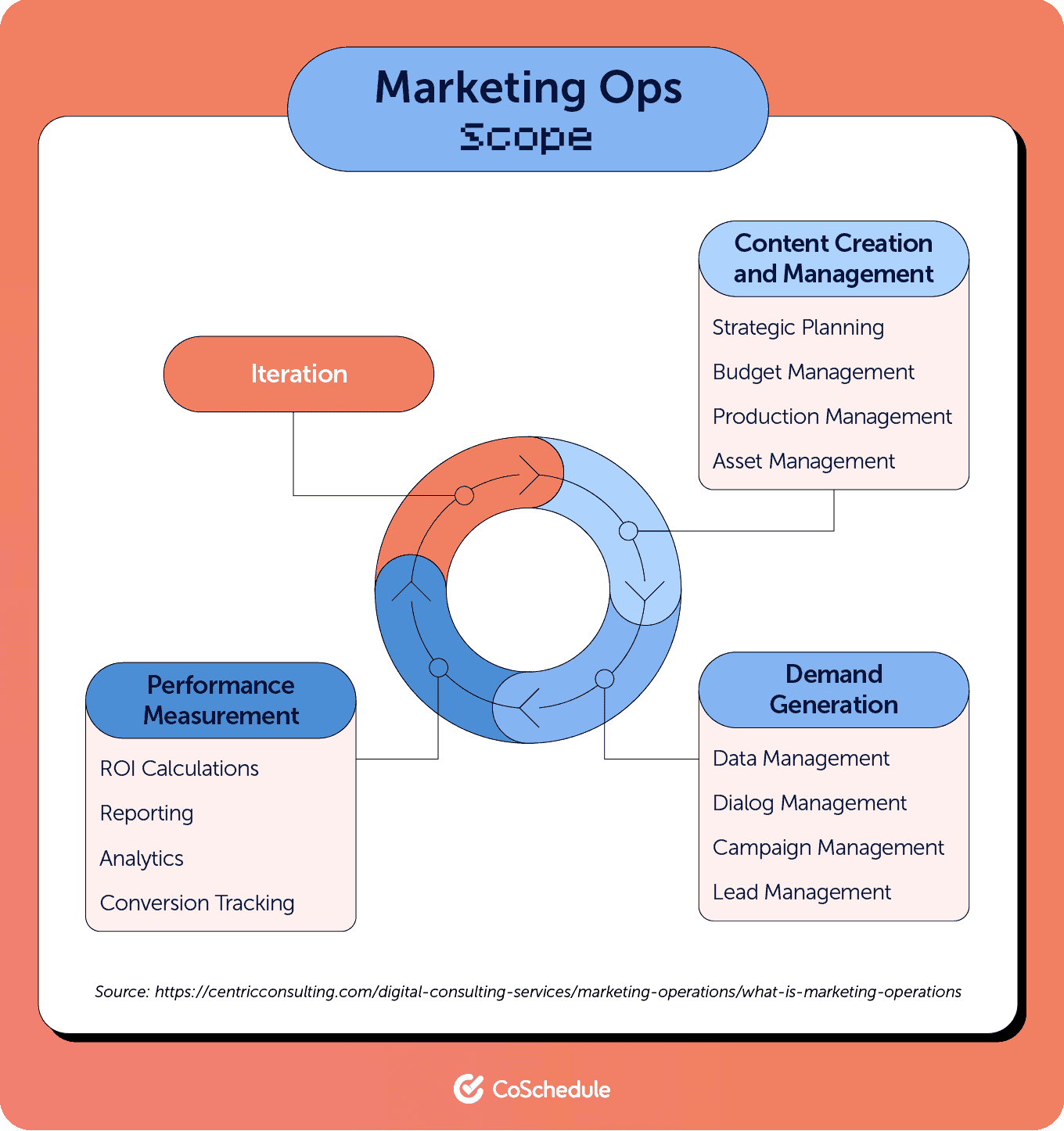
A marketing operations team’s duties fall into a cycle of four steps:
- Content creation and management: Planning the content that goes into a project or campaign and its surrounding processes, assets, and budget
- Demand generation: Managing the data, conversations, campaigns, and leads related to existing content
- Performance measurement: Tracking conversions resulting from marketing and translating analytics into ROI calculations and reports
- Iteration: Using the data collected from marketing to make strategic decisions for improvement
Who Are Marketing Operations Stakeholders?
In addition to the marketing directors and direct contributors who actively participate in marketing work, marketing operations managers must communicate opportunities and outcomes to others in the organization.
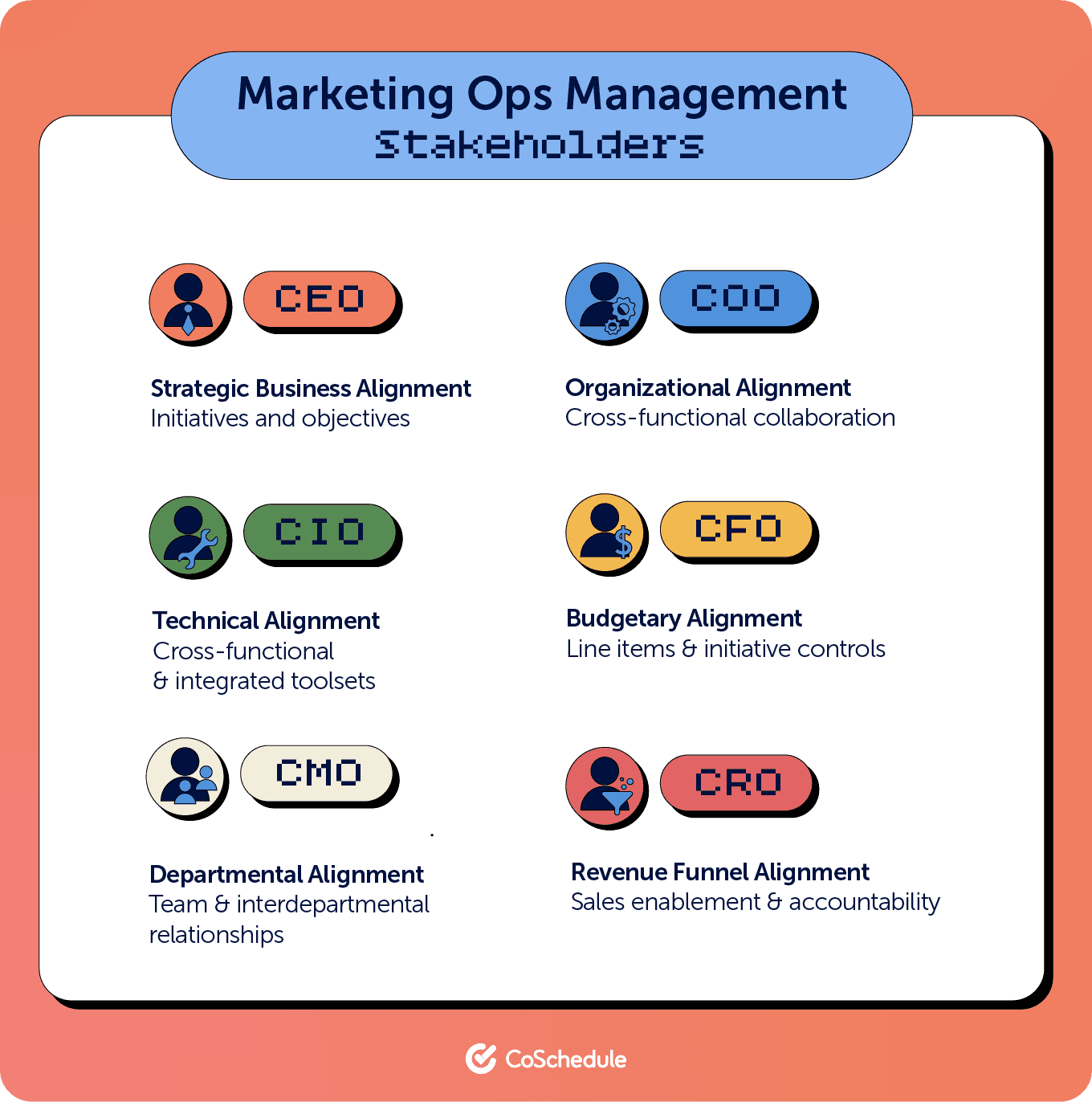
Your organization could have marketing operations stakeholders such as:
- Chief executive officer (CEO): As the highest power in your organization, your CEO wants marketing to align with their strategic business goals. They’ll contribute to your marketing ops by sharing organizational initiatives and objectives.
- Chief operating officer (COO): Your COO cares about how your marketing team will fit into your organization’s operations. COOs enable cross-functional collaboration among teams, including your marketing department.
- Chief information officer (CIO): The CIO, your IT operations leader, prefers to keep marketing technology in line with the rest of your organization’s tech. This person will work with MOps to keep martech working in harmony with the rest of the organization’s technology.
- Chief financial officer (CFO): Your marketing budget’s place in the organization’s finances matters to your CFO — the head of finance. The CFO will provide line item and initiative controls to help marketing stay within financial targets.
- Chief marketing officer (CMO): As your organization’s marketing leader, your CMO wants you to collaborate well with the other marketing team members. They’ll facilitate this process by managing team members and interdepartmental relationships.
- Chief revenue officer (CRO): A CRO can manage any process related to generating revenue, including marketing, sales, and customer support. Since they care about all of these processes working seamlessly, they’ll coordinate sales and customer support operations with your marketing operations.
Marketing Operations KPIs
What KPIs matter to marketing operations professionals? We can best answer that question with input from marketing ops managers themselves.

View the page here.
Gartner’s Agile Marketing Strategy Guide includes data from a survey of hundreds of marketing teams with dedicated marketing ops functions. The marketers they consulted named these KPI categories as the most important:
- Work efficiency: Metrics that measure the marketing team’s ability to create quality work in optimal time, including time per project
- Impact measurement: Marketing project and campaign metrics that track the quality and impact of marketing, such as page views
- Output measurement: The quantity of marketing projects and tasks completed in a period of time, measured through metrics like blog posts per month
- Alignment to business goals and strategic plan: Custom metrics specific to the marketing team’s ability to contribute to the organization’s overall objectives
- Internal stakeholder satisfaction: Metrics measuring stakeholders’ approval of the marketing team’s results, like scale ratings
- Use of marketing technology: Measurements of the marketing team’s tech usage, such as projects created in a specific software
How To Create A Marketing Operations Strategy
Now, let’s combine all the concepts we’ve learned into a strategy you can follow for your marketing team. Follow these steps to get your marketing operations running:
1. Establish Goals, Objectives, & KPIs
Before planning any other part of your marketing ops strategy, set the goals, objectives, and KPIs you want to achieve. Every other aspect of your strategy will tie back to these intentions.
Start with goals — the high-level outcomes your marketing operations should influence. For example, your marketing department might aim to increase visitors to your blog content by 150% in one year.
Notice how this goal has clear metrics and a timeframe. At CoSchedule, we always encourage readers to make goals SMART: specific, measurable, attainable, relevant, and timely. Our guide to setting SMART marketing goals (SMARTketing goals?) will teach you how.
Once you create a solid list of goals, break them down into objectives. The objectives for your marketing ops plan will be targets that will influence your high-level goals when you complete them. Make these objectives SMART, too, by considering the “who,” “what,” and “when” of your actions.
For example, a SMART objective for our blog could read something like, “By the end of this quarter, the Marketing Operations team will have a defined workflow process in place for creating blog posts with handoffs from the following teams: Content Strategy to Content Marketing to Marketing Design to Editorial, with all tasks completed in two business weeks.”
With your goals and objectives settled, it’s time to choose marketing KPIs to measure progress toward your goal. Establish where and how you want to track those KPIs, too. Going back to the blog traffic goal, we could use Google Analytics’ website visitors metric as a KPI.
2. Define Stakeholder Roles & Communicate Participation Expectations
After you plan your goals, objectives, and KPIs, figure out how your organization’s key members will contribute to them. Categorize your stakeholders into four roles:
- Awareness: These top-level stakeholders benefit from you meeting your marketing goals, but they don’t decide how you execute them. Examples can include your CEO and COO.
- Approval: As the name suggests, these stakeholders approve goals and strategies based on the resources they oversee. They need to know what your marketing team is doing so they can let you know if it’s feasible in your organization. These stakeholders could be figures like your CIO and CFO.
- Opinion: The stakeholders in this category provide opinions on actualizing your goals, but they don’t have to be involved in execution. Depending on your organization’s structure, this group might have your CRO, CEO, or COO.
- Execution: Stakeholders in the execution group are responsible for executing the actions that contribute to your goal. These people could include your marketing team and your CMO.
Note that the examples we provided don’t apply to every organization. For example, the CEO might make direct marketing decisions in a smaller workplace.
3. Set Milestones & Steps Toward Goal Actualization
With your goals and stakeholder roles established, you can plot out the steps it’ll take to achieve your goals. Set higher-level milestones and detail the steps involved to reach each milestone. Write out every little action and break them down into their smallest parts.
But let’s back up for a second— what exactly is a milestone?
A milestone is an action or event that marks progress toward a goal.
Here are some example milestones for different goals:
- Reaching a 50% increase in blog visitors when working on getting a 150% increase
- Writing ten blog posts out of your 100-post goal
- Automating marketing tasks 50 times when you want to reach a goal of 500 automated tasks
Create a list of your marketing goals and objectives, then add milestones for each. In between each milestone, write down the actions needed to achieve them. Your final result should look like a step-by-step guide to achieving your goals.
Once you finish your milestone list, add feasible deadlines to each step based on the timeline you set in your SMART goals and objectives. Our resource on setting deadlines will provide guidance.
Then, list everyone involved in each step and how they’re involved.
Now that you visualized your goal-making process, you can plug all the steps into your marketing calendar.
4. Establish Communication Frameworks & Ceremonies
It’s time to decide how you’ll communicate your day-to-day actions, goals, and progress with everyone involved in your marketing. Answer these questions together with your team:
- What can we improve on in our current approach to communication? The answer to this question will influence how you answer others.
- In what way and how often should the marketing team update each other on department matters? This question will establish your department’s communication methods.
- In what way and how often should the marketing team update outside stakeholders on marketing progress? Here, you’ll figure out how to communicate with stakeholders outside your department but inside your organization.
- What ceremonies will we use to touch base with each other? Ceremonies are frameworks for meetings, such as sprint planning or brainstorming.
You might consider using an existing collaboration framework, like agile scrum. From there, you can modify your communication methods over time to suit your organization.
5. Assign Work To Stakeholders
At this point, your marketing operations game plan is about ready to go — you just need to decide who will do what. Take notes from your milestone planning session and assign each step to the people involved.
Keep your marketing team’s structure in mind as you divvy out your assignments. If you have a few generalists, for example, consider their specific strengths, professional development goals, and workloads. Or, if you have a cross-department designer, you’ll need to coordinate with other teams and the designer themself to keep timelines realistic.
Some methods for assigning marketing projects include using a shared marketing calendar or your favorite project management app.
6. Measure Performance & Report To Stakeholders
This final step is an ongoing task for marketing operations managers. As your team completes marketing projects, you’ll monitor their performance and report the results to stakeholders.
Use a tool like Google Analytics or an app’s native analytics to track your projects’ marketing analytics. Marketing software like CoSchedule gathers analytics from multiple platforms so you can watch them all in one place.
As you set up your analytics workflow, go back to your defined KPIs. Make them easy to find in your tool with a bookmark or custom dashboard.
Once your analytics technology is ready, you can decide on a reporting workflow. Many analytics apps let you generate reports. But, if you’re grabbing data from multiple tools, you may need a dedicated reporting tool or spreadsheet.
Our marketing reporting template is a pre-formatted spreadsheet you can fill in and share with stakeholders. Add and modify the fields to fit your KPIs.
With a reporting format under your belt, you can use it to report your marketing analytics to your stakeholders every month, quarter, and year.
Marketing Operations Best Practices
As you develop your marketing operations workflows, keep these best practices in mind:
- Keep your marketing ops cross-functional and cross-departmental to streamline your operations across your organization. Our tips for managing a cross-functional team will help you stay on track.
- Let your analytical (left-brain) leadership drive creative (right-brain) execution. Pay attention to your marketing metrics and let those results influence your creative decisions.
- Measure operational metrics alongside marketing metrics. Operational metrics like customer acquisition cost (CAC) track your marketing operations’ effectiveness, not just your marketing.
- Automate redundant tasks. Check your current apps for automation features like repeatable tasks. Or, use a specialized automation tool that connects apps.
- Make a habit of reporting and data hygiene. Set aside time regularly to report your metrics and keep your data clean and consistent.
- Use templates to save time. Make templates for reports, emails, and other documents for which you can repeat the format.
How To Manage Marketing Operations With CoSchedule Marketing Suite
Managing marketing operations is easy with CoSchedule Marketing Suite. With Marketing Suite, you can easily manage, communicate and schedule out projects effectively all within the same place.
Track Goals And Plan Out Objectives
Add a tracking tag to all of your projects or campaigns to identify how projects are aligned with company goals and objectives.
![]()
Once you add these tags, you can easily track your progress & plan future projects with these goals in mind using custom views of your Calendar, Idea Backlog, & more.
Easily Prioritize The Right Projects At The Right Time
Not sure what project is up next?

Grab prioritized projects from your Idea Board to drag & drop them on your Calendar.
Use Saved Views to sort projects and incoming requests on your backlog in Idea Board to easily find the work that will have the biggest impact on achieving specific objectives.
Define Stakeholder Roles & Communicate Participation Expectations
Without processes in place for communication, it’s easy to spend too much time collecting stakeholder feedback to complete projects.
Create Read-only views of your Idea Backlog and Calendar to ensure you’re working on the right priorities in the right order.

Share these views with stakeholders, so they are aware of what you’re working on, easily approve next projects, and provide their feedback if priorities do change.

When you get buy-in from stakeholders, you can confidently assign out approved projects to ensure your team continues to on the right priorities.
Set Milestones & Steps Toward Goal Actualization
With Marketing Suite, you can add deadlines for your upcoming projects to make sure all projects and campaigns are completed on time.
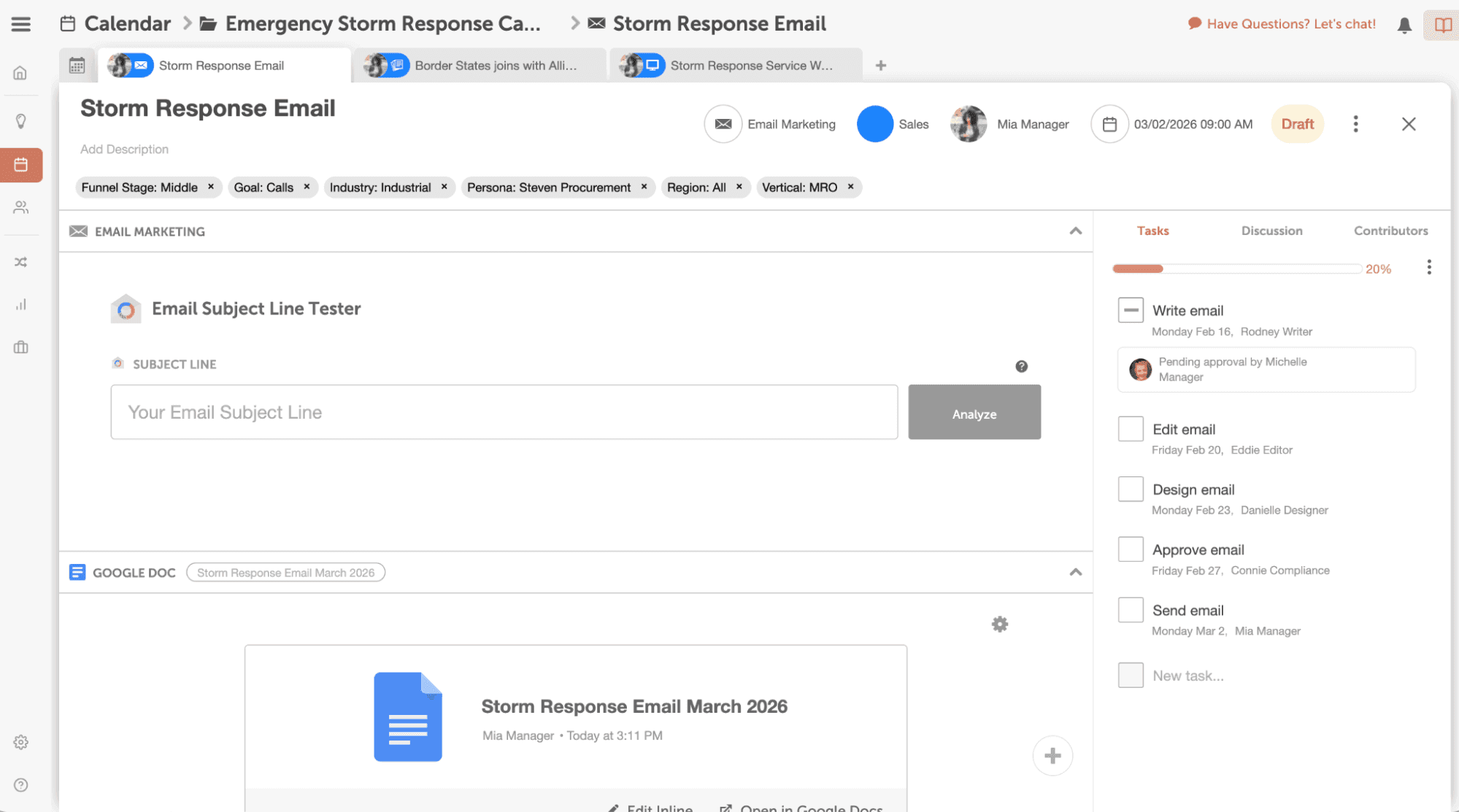
This helps you set deadlines & milestones for larger campaigns, so you can make sure everything is completed in time for launch.
Another way to track progress is to create a Project Report.

If you have goals towards producing more content or completing projects for a specific initiative, use Project Reports to demonstrate what your team has produced and accomplished this month, this quarter, and beyond.
Establish Communication Frameworks & Ceremonies
Communicate with your team effectively in Marketing Suite to stay up-to-date on projects and tasks.
Collaborate With Your Team
Simply tag one of your team members in discussions on any project to collaborate with your team.

All conversations about the project are documented inside the project, which provides a record of decisions, feedback, & more.
Manage Incoming Requests
If you’re working with other teams in your organization, use Request Forms in Marketing Suite to organize incoming work.
Share a link to your Request Form to ensure your team has all the information they need to successfully field new requests.
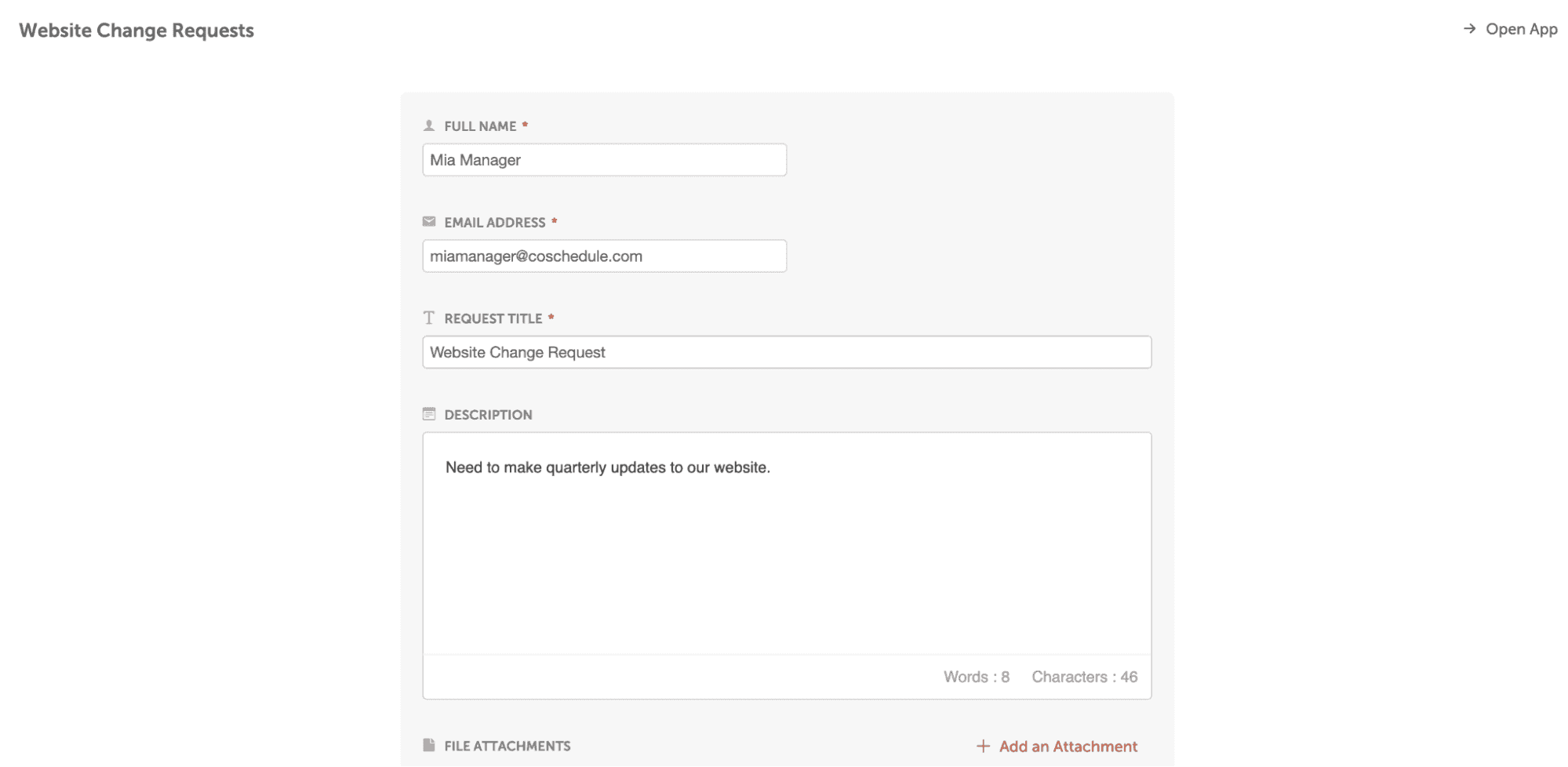
Build forms for specific projects including Press Releases, Business Cards, Website Change Requests, & more.
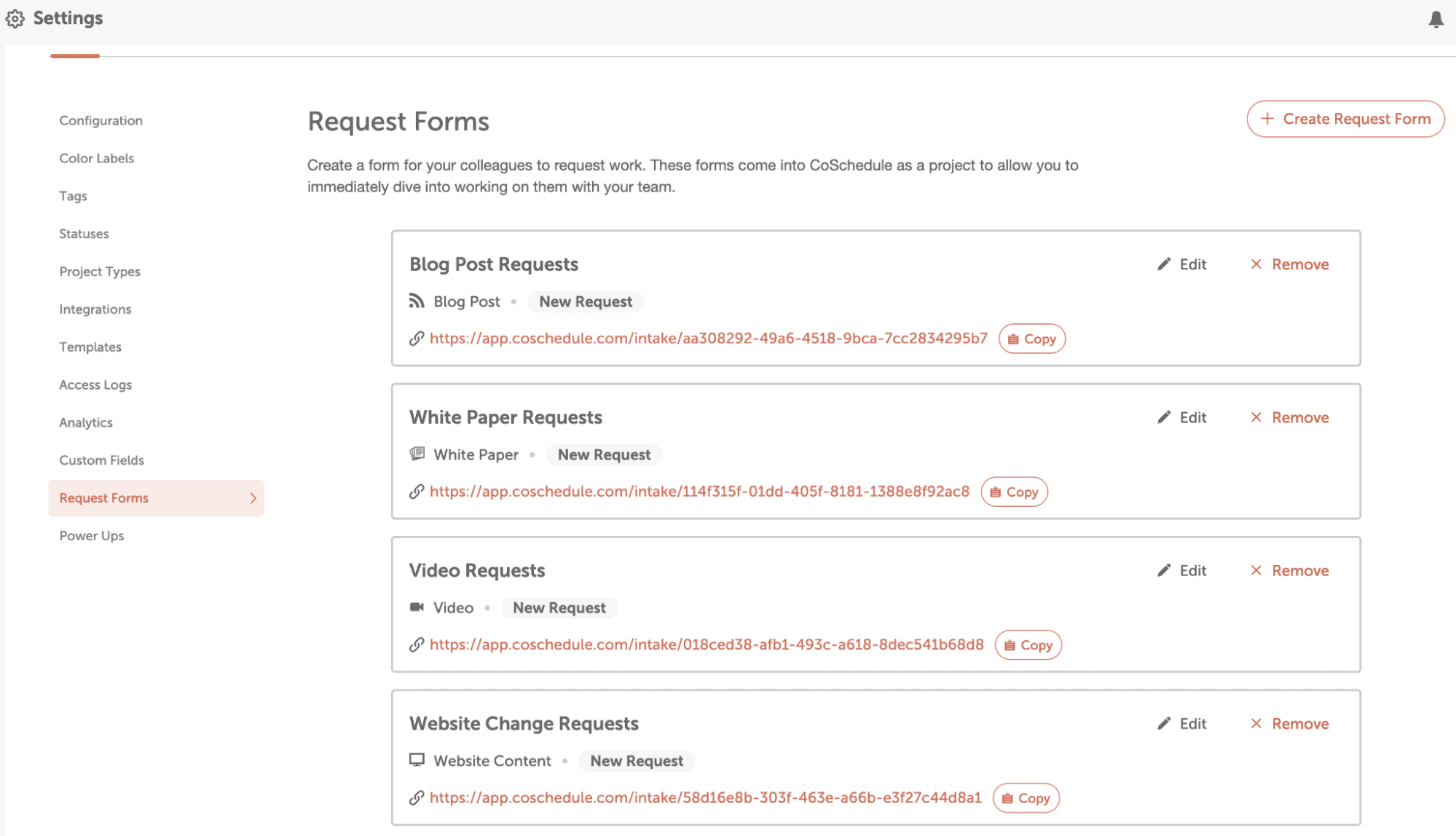
Communicate Updates In Real-Time
With Read-Only sharing, you can create custom views of your Calendar, Idea Board, or Table View to give your stakeholders real-time updates on marketing projects.

Assign Work To Stakeholders
Keep your stakeholders informed by assigning work to your calendar.
Task Templates – assign work & deadlines to your team to keep projects on track.
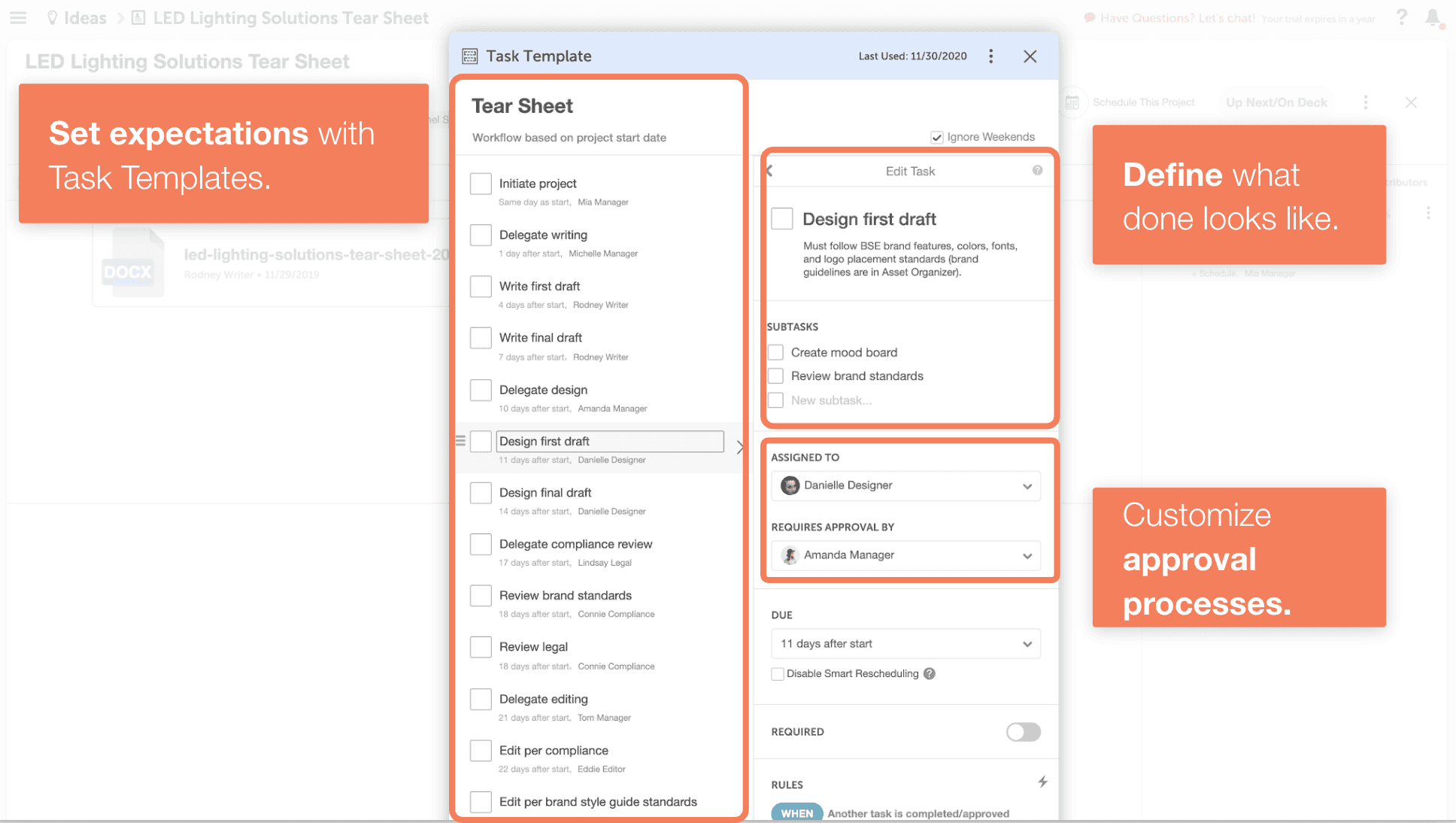
Cross-Department approvals – share updates via Read-Only Views
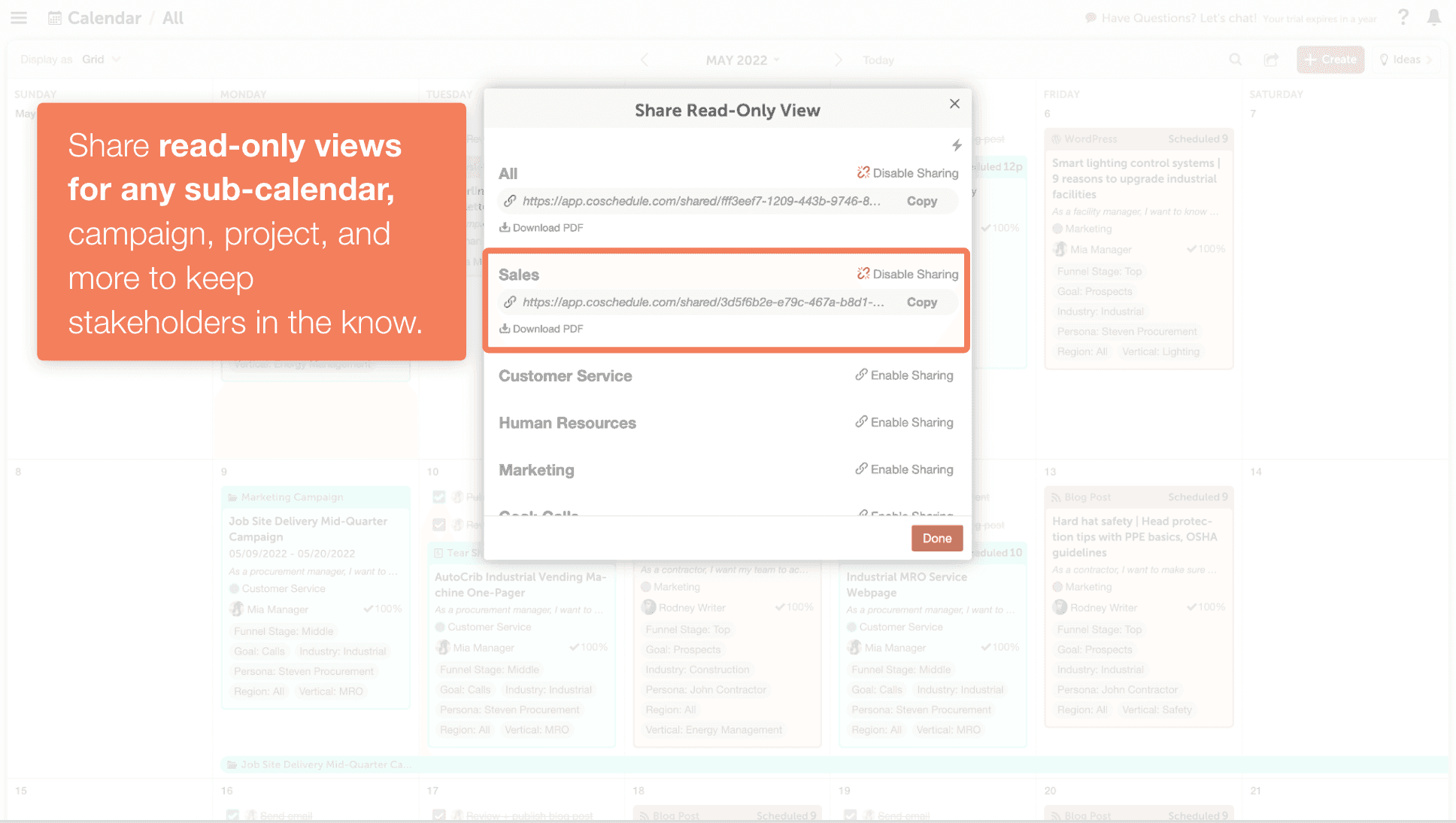
Measure Performance & Report to Stakeholders
Marketing Suite features Project Reports and Campaign Reports to help you demonstrate what the marketing team has completed for specific teams, departments, and initiatives.
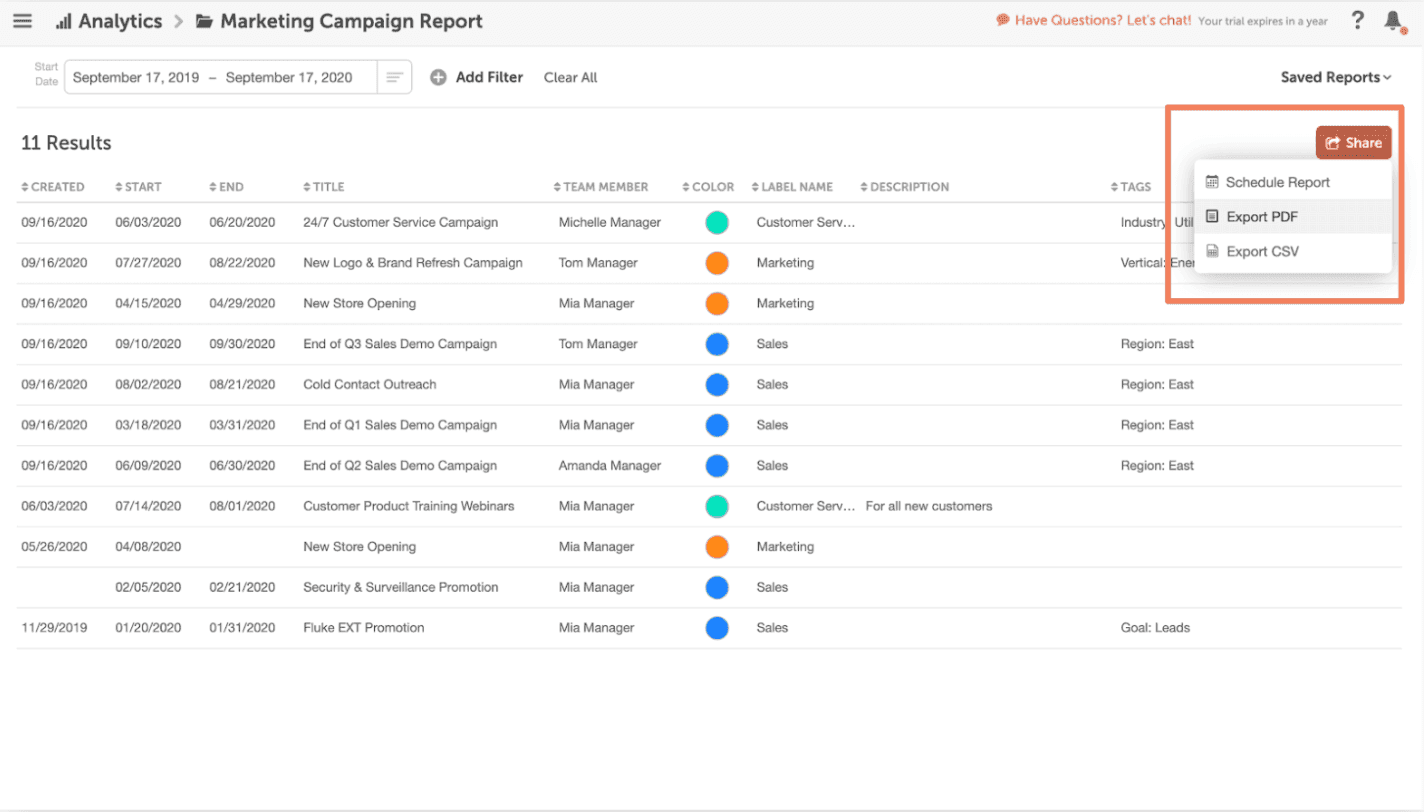
You can build custom reports for your stakeholders and schedule them to be delivered to their email address monthly or download as a PDF to share in upcoming meetings.
Marketing Suite is an excellent tool for marketing operations management as it offers a comprehensive suite of features designed to streamline workflows, integrate marketing plans, and provide data-driven insights to help teams make informed decisions.
Learn more about Marketing Suite or schedule your demo today.
Recommended reading: Resume Title Generator
